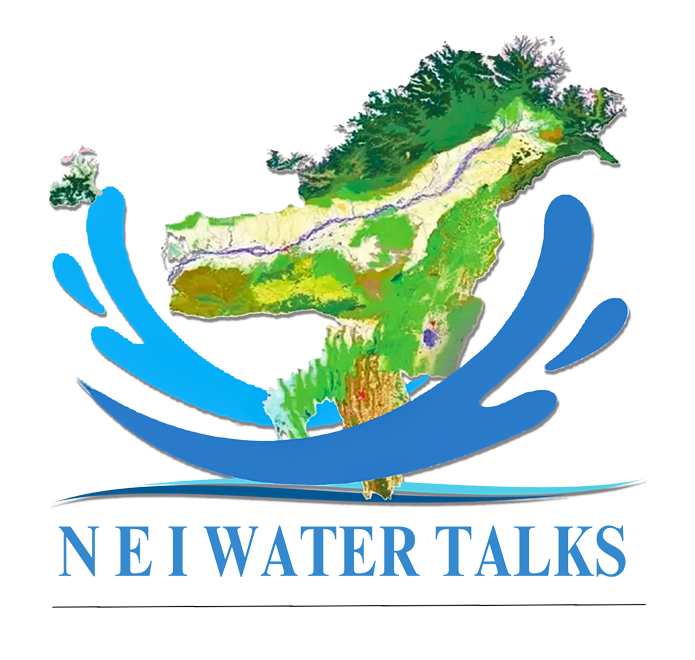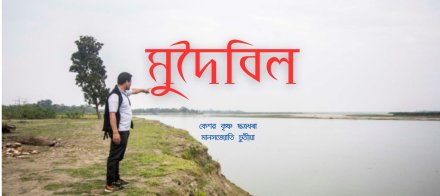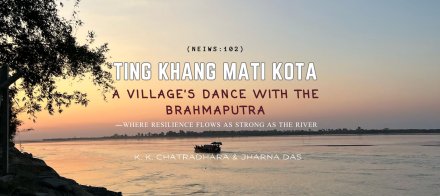Gai Noi (River) Jalashay (Wetland): A Wetland that attracts NH15
Gai Noi (River) Jalashay (Wetland)
It was in November 2022. When I was driving from my home in Sisibargaon to Dhemaji, I saw many people standing on national highway 15 near the river called 'Gai Nai' and looking at the colourful birds in the nearby water body. This site has become a familiar on the banks of the Gai Noi every winter for the past decade. As winter approaches, birds are celebrated in the rivers, beels, and water bodies of Assam. During this time, many birds from different parts gather in rivers, lakes, and other water bodies. The sweet beauty of nature is felt by those who are confronted with this warm noise of birdsong. The rainy season celebrates the festival of water itself here every year. From November to March, when winter arrives at the banks of the Gai Noi, birds celebrate their festival. The place is called Gai Noi Jalashay because people who drive on the national highway 15 call it that. On the other hand, it is also a familiar site for the people nearby to community fishing.
What does wetlands mean:
Wetlands are a very important part of nature. In a general sense, the area where water has accumulated or is surrounded by for most of the year is called water bodies or wetlands. The water bodies located near rivers, lakes, canals, farms, swamps, pits, or other vegetation, have been commonly identified as wetlands.
Importance of wetlands:
The aquatic plants that are commonly found floating in the wetlands and the grasses that are grown in dry areas are as important as the other plants. The green plants in wetlands release the same amount of oxygen gas as other plants. This is called phytoplankton. In addition, these plants in the water help keep the water clean and healthy. Wetlands around rivers can reduce floods by holding water during rainy seasons, cleaning polluted water from nearby areas, and keeping the environment healthy. We all know that the number of wetlands in our state is decreasing slowly. This causes the monsoon water level to go up every year and become very dangerous.
The economic significance of these wetlands is immense. The rivers and wetlands of Assam have made the state more prosperous in terms of fish. These wetlands are the main fishing spot in our state. These wetlands serve as a refuge for indigenous fish in Assam for numerous fishing families. It is clear that the tourism industry has immense potential in the wetlands if the facilities for fishing, boating, etc. are available.
Not only fish, but also other species of animals, birds, are an integral component of the wetlands. They work together in the food chain. The presence of birds serves to sustain the distinctive ecosystem by enhancing essential elements such as phosphorus, nitrogen, and other essential elements. Therefore, the villagers should do everything they can to stop birds from being killed in the wetlands. Also, the various aquatic plants present in the wetland prevent the flow of water and help in reducing the severity of floods and prevent erosion.
Gai Noi Reservoir:
There are many rivers in Dhemaji that are part of a larger area called 'Dholor Dhemalir Thali'. There are several rivers, both small and large, as well as beels, water bodies, or wetlands. Among them, the 'Gai Noi Jalashay' near the Gai River under the Sisibargaon revenue circle is a small wetland.
Numerous species of birds that have made their way to this water body or wetland during the months of October-November serve as the primary focal point of attraction. It is worth mentioning that out of the about 180 aquatic birds found in Assam, 105 are migratory. On the other hand, out of about 1285 species of birds found in India, about 814 birds are found in Assam. This migration of birds is about where they live and how they reproduce. Fish are the primary food source for aquatic birds, although they also consume other aquatic foods. Therefore, they roam in beel and pits. Wetlands are chosen as centre of bird movement and breeding.
Since October, different birds sing in the river wetlands and make it look pretty with their sweet sounds. Each year, colourful birds come and go in and out of the water on the banks of the Gai river. They make noise in different tones all day and night. About fifty birds can be seen in the local and migratory species of Sharali, Chakaiskuwa, Mugi Duck, Godhakali Duck, Rangamuri Duck, Kheri Duck, Pati Duck, Futuki Duck, Jongneji Duck, Pani Crow, Snail Breaking, Snail Breaking, Hadgila, Bortokola, Azaan, Bor Azaan, Masuroka, Bagli, Bog, Kanamusuri, Itaguriya, Wak Bird, Bordubi, Pani Dubi, Daikla etc.
In addition to other times, especially in the winter, thousands of migratory aquatic birds flock to the water body. It is in the midst of the musical noise of thousands of birds gathered in this water body that it is as if in the morning, it is as if the villages of Tokoubari, Bhaveli, Theraguri, Gaijan, Gaideuri, Hathigarh, Janakalayan, Sapekhati etc. The entire wetland is surrounded by the water bodies of the vibrant birds, the picturesque scenes of the birds coming and going, and the waves created by their different melodies, throughout the day and night.
Due to the unrestricted movement of humans, unplanned fishing of fish and turtles, and the abominable actions of unscrupulous individuals who have set up nets and employed poison, the birds that inhabit the water body are currently in a dire situation. On Diwali, when there are fireworks in nearby villages, birds fly around in fear. The government, forest department, administration, nature-loving organizations, and interested individuals have the ability to take initiatives and safeguard the water body by ensuring its proper conservation.
The Dhemaji's wetlands are in crisis.
The water is life, and civilization has emerged around it. In Dhemaji district too, all the villages have been grown along the rivers and beels. Once, people collected the water needed from rivers, beels, and ponds for agriculture, drinking, and washing. During the great Assam earthquake of 1950, a lot of landscape change happened. Because of the earthquake, the rivers and beels were also in bad condition. The source of these rivers become terrible in the up hills of Arunachal Pradesh, so the debris comes down and the riverbed starts to rise, and the beels get choked. Furthermore, due to the indiscriminate destruction of forests and the continuous floods, the wetland ecosystems in the district are being destroyed.

There is a shortage of water, and the water is causing danger. As canals and water bodies are being destroyed, conflicts over water are becoming more common in the area. Over the past six to seven decades, the persistent flood from the Gai, commonly known as the tear of Dhemaji," has caused significant erosion of numerous wetlands, including Padumni, Kasmari, Kanibil, Bheheki, Lechia, Kukuraura, Bet Bhandar, Kerekoni, Kharbil, and others in the Sisibargaon region." Many bird species, fishes and graze land for animals were lost due to this. Only two-three wetlands are able to sustain now near the Brahmaputra, where the migratory birds as well as fish and other aquatic animals are still present. But they are all in trouble.
At present, due to various reasons such as encroachment, erosion, construction of roads, and dumping, the wetlands are gradually beginning to become a threat. It's nice to build houses and factories, but dumping garbage from hotels and restaurants near wetlands is a big problem right now. Most of the time, things like plastic bags, chemicals, and pesticides from cities and towns pollute the wetlands.

Comment [1]
Lat Gaon Bura, Chandan Jiamaria of Vebeli village "Due to the floods of the Gai River and encroachment of people, the vast wetland and forest called Kerekani disappeared. Because of this, the natural environment of the entire area has been affected. The natural balance of the species has also been lost. The area which was previously in wet condition now faces a drought and water crisis. The water level in the rivers and ponds or Tubewells drops to a low point, making it difficult to obtain the essential water needed by the inhabitants."
Comment [2]
Narakant Sutia, a resident of Gaijan village, said,"There has been a slight change in the natural environment of the adjacent areas. Animals can't find enough water to drink. The water level in the area is very low because of the loss of wetlands."
Comment [3]
Toldhar Hazarika, an elderly person from Bhebeli village, says, “The area was abundant with fish because of the wetlands near the Gai River. But gradually, huge beels, wetlands like Kanibil, Kerekoni, Lalungtinali, and others have disappeared. As, the fishes also disappeared with these wetlands from the area, which led to a crisis for fish dependent people.”
According to the Department of Management of Natural Beels, 70% of Assam's water has been polluted due to industrial and waste pollution in the last 50 years. The World Watch Institute in Washington remarked that India is on the verge of becoming a water-deficient nation from 2020. Such situations have arisen in many places. If the wetlands disappear for different reasons, it will harm nature and the diversity of animals and plants. That's why we need to keep wetlands safe.
Geolocation is 27.567099953262918, 94.6601367


